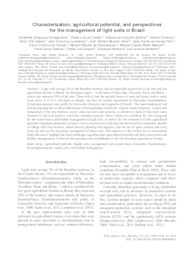Characterization, agricultural potential, and perspectives for the management of light soils in Brazil.
Characterization, agricultural potential, and perspectives for the management of light soils in Brazil.
Autoria: DONAGEMMA, G. K.; FREITAS, P. L. de; BALIEIRO, F. de C.; FONTANA, A.; SPERA, S. T.; LUMBRERAS, J. F.; VIANA, J. H. M.; ARAUJO FILHO, J. C. de; SANTOS, F. C. dos; ALBUQUERQUE FILHO, M. R. de; MACEDO, M. C. M.; TEIXEIRA, P. C.; AMARAL, A. J. do; BORTOLON, E. S. O.; BORTOLON, L.
Resumo: Light soils occupy 8% of the Brazilian territory and are especially expressive in the new and last agricultural frontier in Brazil: the Matopiba region ? in the states of Maranhão, Tocantins, Piauí, and Bahia ?, where they represent 20% of the area. These soils fit into the textural classes of sand and loamy sand or sandy loam, down to 0.75-m soil depth or deeper, and they are mainly represented by Neossolos Quartzarênicos (Quartzipsamments) and, partly, by Latossolos (Oxisols) and Argissolos (Ultisols). The understanding of soil functioning depends on the establishment of distinguishing criteria for: organic matter dynamics; content and mineralogy of the clay fraction; coarse sand and total sand contents, in relation to those of fine sand; mean diameter of the sand fraction; and water retention capacity. These criteria can contribute for the zoning and for the conservation and fertility management of light soils, as well as for the estimation of their agricultural potential. Integrated production systems, such as crop-livestock and crop-livestock-forestry integration, besides no-tillage with crop rotation, mixed forestry planting with legumes, and the use of green manure and cover crops are relevant for the proper management of these soils. The objective of this review was to characterize light soils and to highlight the main challenges regarding their agricultural potential and their conservation and fertility managements, in face of the expansion and consolidation of the new Brazilian agricultural frontier.
Ano de publicação: 2016
Tipo de publicação: Artigo de periódico
Unidade: Embrapa Solos
Observações
1 - Por padrão são exibidas publicações dos últimos 20 anos. Para encontrar publicações mais antigas, configure o filtro ano de publicação, colocando o ano a partir do qual você deseja encontrar publicações. O filtro está na coluna da esquerda na busca acima.
2 - Para ler algumas publicações da Embrapa (apenas as que estão em formato ePub), é necessário ter, no celular ou computador, um desses softwares gratuitos. Sistemas Android: Google Play Livros; IOS: iBooks; Windows e Linux: software Calibre.
Acesse outras publicações
Acesse a Base de Dados da Pesquisa Agropecuária (BDPA) para consultar o acervo completo das bibliotecas da Embrapa.

